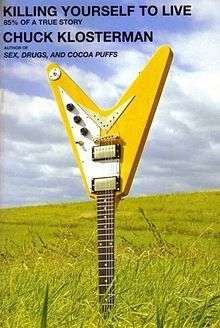Killing Yourself to Live: 85% of a True Story
 2006 paperback edition cover | |
| Author | Chuck Klosterman |
|---|---|
| Country | United States |
| Language | English |
| Subject | Death, rock music |
| Publisher | Scribner |
Publication date | June 28, 2005 |
| Media type | Print (hardcover and paperback) |
| Pages | 256 |
| ISBN | 0-7432-6445-2 |
| OCLC | 60684970 |
| 781.660973 22 | |
| LC Class | ML394 .K59 2005 |
| Preceded by | Sex, Drugs, and Cocoa Puffs: A Low Culture Manifesto |
| Followed by | Chuck Klosterman IV: A Decade of Curious People and Dangerous Ideas |
Killing Yourself to Live: 85% of a True Story is a work of non-fiction written by Chuck Klosterman, first published by Scribner in 2005. The title is a reference to the 1973 song Killing Yourself To Live, by the heavy metal band Black Sabbath. It is the third book released by Klosterman. Klosterman constructed the book around the premise of writing magazine feature about death, particularly deaths involving rock 'n roll stars. The actual feature, published in Spin in 2003, shares some ideas and language with the book.[1]
Story outline
The true meaning of Klosterman's search, however, often has little to do with the actual circumstances leading to said deaths, instead focusing on the existential implications and cultural realizations that result. To these ends, Klosterman engages on an "epic" road trip, visiting the death sites of rock stars such as Duane Allman and Kurt Cobain. In a rented Ford Taurus, which he nicknamed "Tauntaun", Klosterman runs into a variety of interesting circumstances and people along the way, such as a teenager in Missoula, Montana, who asks Mr. Klosterman to sell her some cannabis or a Cracker Barrel waitress who reads Kafka.
A very large part of the narrative rests on four women from Klosterman's past and present who embody abstractions that he loves (and are later compared to the four original members of KISS). In the same way that a rock star's death grants them a transcendence of anything that they may have embodied during the course of their life, so, too, these four women transcend their own effect on Klosterman to become the molds by which all other women will undoubtedly fall short.
Klosterman also does much literary analysis of songs and retelling of conversations from his past. A good example of this is:
"[Elizabeth Wurtzel] is a terrible, terrible writer," said Lucy. "Oh, I don't know if I agree with you," I said. "Do you remember that part of Prozac Nation where she talked about playing the Beatles when she was thinking of killing herself? And how that whole idea sort of addresses the concept of art to understand death, not unlike the manner in which art is often used as a prism for understanding life? That's brilliant, I think. I think maybe Elizabeth Wurtzel is brilliant." "That's dubious," said Lucy. "Why do you say that?" "Because people who seriously want to kill themselves don't worry about which Beatles song they'd play while their bathtub fills up with blood. Those kind of people probably don't even like the Beatles." "Lucy, there's nothing to indicate that suicidal people don't like the Beatles." "Well, true," said Lucy. "There's no data on this sort of thing. But it's not like people who want to die spend their afternoons rifling through their record collections." "Oh yes they would!" I insisted. "If I was committing suicide, I would totally worry about what Beatles song I would play. That's all I would worry about. I'd probably pick "Tomorrow Never Knows," but I'm not sure it's long enough. I'm not sure I could bleed to death in two minutes and 56 seconds."
"Dubious," she replied.
Klosterman also makes a bold statement about Radiohead's Kid A, proclaiming that track-by-track the 2000 album unintentionally details the events of the September 11 attacks, which would occur 11 months after its release.[2]
References
- ↑ Klosterman, Chuck (2003-11-25). "6,557 Miles To Nowhere: Death is part of life. Generally, it's the shortest part of". Spin. Retrieved 2009-10-25.
- ↑ http://www.powells.com/review/2005_06_25.html
External links
| Wikiquote has quotations related to: Killing Yourself to Live: 85% of a True Story |
- Killing Yourself to Live at Simon & Schuster
- Largehearted Boy Book Notes music playlist by Chuck Kosterman for his book, Killing Yourself to Live